Whales are amazing creatures that many people don’t know are viewable during certain parts of the year in the Long Island Sound. The best time to catch the beautiful and graceful giants is from July until the beginning of September. New York isn’t a place that is automatically connected to animal viewing, especially those of the aquatic variety. Long Island did make the news a few times recently when several swimmers had close calls with sharks. It is a phenomenal feeling to watch whales breach and dive back into the deep water of the sound. It has become such a tourist attraction that whale-watching tours can now be scheduled for a fee. Let’s take a look at which types of whales you might just be lucky enough to see on a whale tour.
1. Blue Whale (Balsenoptera musculus)

Blue Whales (
Balsenoptera musculus) are the largest whales in the world and occur in the Long Island Sound.
©Danny Sullivan/Shutterstock.com
Appearance: Greyish blue with white on the bottom side of their dorsal fins and tail.
Size: 90 – 110 feet, with the largest whales in the Antarctic.
Weight: 290,000 – 330,000 pounds. In the North Pacific and Atlantic, they weigh 100,000 pounds or more, but the larger weights are found on whales in the Antarctic.
Speed: 12 miles per hour on average and 35 miles per hour in short bursts
Lifespan: 80 – 90 years
Conservation Status: Endangered, though their numbers are increasing slowly.
Info: Blue whales are the largest animal on earth and are the length of three full-sized school buses combined! Even the whale shark doesn’t even come close to the whale’s size at a mere 40 feet long. Their numbers were low, and they were headed for the title of extremely endangered.
In the 1900s, the commercial whaling industries claimed the lives of most of the blue whales, along with many other species. Since then, the numbers have been slowly increasing, though they are still endangered. The blue whale‘s major predators are still humans getting caught in large fishing nets and also getting hit by large vessels. Their only natural predator is the killer whale. Killer whales swim in pods and attack like wolves of the sea in a team.
2. Fin Whale (Balaenoptera physalus)
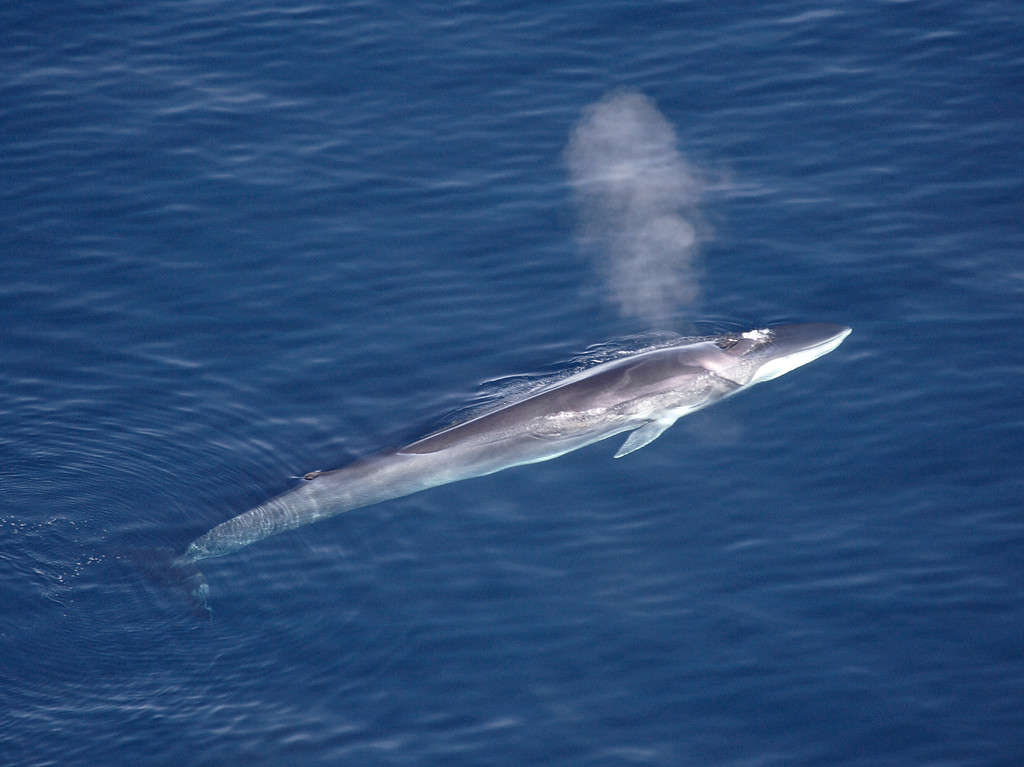
Fin whales (
Balaenoptera physalus)have a long, slender torpedo-like shape.
©Aqqa Rosing-Asvid – Visit Greenland, CC BY 2.0 – License
Appearance: Grey, black, and dark brown upper with a pale underside. The left side of the jaw is black and the right side is white.
Size: 61 – 73 feet long, with females being larger than males.
Weight: 100,000 pounds
Speed: 23 miles per hour is their normal speed, but they can hit 29 miles per hour in short bursts.
Lifespan: 90 years
Conservation Status: Endangered but is listed as extinct with the Marine Mammal Protection Act because extinction is likely.
Info: Fin whales are the second largest whales and are closely related to the largest, the blue whale. They prefer cooler waters to tropical ones but can occasionally be found there. The whales are commonly sighted in the Long Island Sound along with other large whales. Their only known predators are humans and killer whales. The calves are more susceptible to attacks than adult whales. As with all whales, the fin whale falls victim to fishing nets and large vessels frequently. Other threats are climate change, habitat loss, and toxins. Sadly, the whales are still hunted by Norway, Iceland, and Japan.
Fin whales hunt for small fish and krill by lunging into schools of the tiny morsels. They are known as the greyhound of the sea due to their fast speed.
3. Humpback Whale (Megaptera novaeangliae)
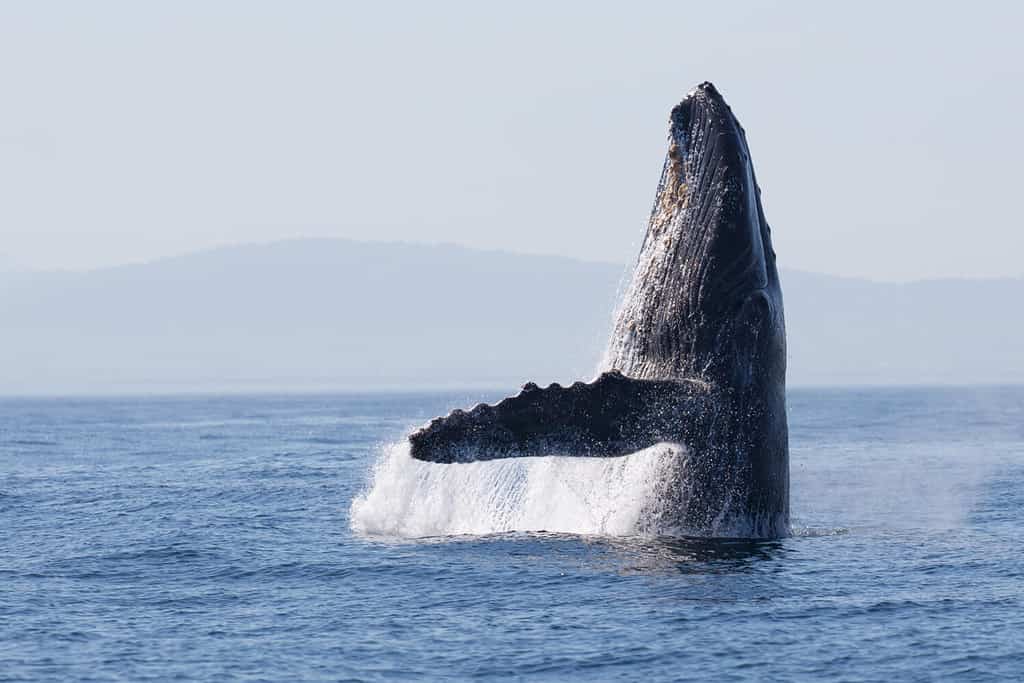
Breaching humpback whales (
Megaptera novaeangliae) are something whale watchers always hope to see on tours.
©Tory Kallman/Shutterstock.com
Appearance: The humpback whale is greyish black while on their extremely long pectoral fins, underside, and on their fluke or tailfin. The white coloring on their flukes is similar to fingerprints on a human; no two are the same. Their head and pectoral fins have a knobby look. They also have a hump on their back, of course.
Size: 60 feet long
Weight: 66,000 – 80,000 pounds
Speed: 3 – 6 miles per hour is the usual speed, but can swim at bursts of 16 miles per hour.
Lifespan: 80 – 90 years
Conservation Status: Least concern and increasing
Info: Humpback whales are massive, gentle giants who have been recorded saving animals from killer whales. They are a member of the baleen whale family and are known for their beautiful breaches. The whales also have an incredible song they sing under the sea. The songs can go on for hours with the longest recorded being 23 hours! The males are typically the ones singing the super long songs that can be heard on land if they are nearby. Humans cannot hear the entire song since the highs and lows are out of our These whales have one of the longest migrations of any animal on earth and can be found in every ocean.
Their flukes can be 18 feet wide and are a way for researchers to identify each whale sighting. As baleen whales, they filter their tiny bits of krill through baleen plates. The gentle giants have also been seen jumping out of the water and playing, making them one of the more playful whales.
4. North Atlantic Right Whale (Eubalaena glacialis)

The North Atlantic right whale (
Eubalaena glacialis) is a critically endangered whale you may be lucky enough to spot in the Long Island Sound.
©6381380/iStock via Getty Images
Appearance: Broad, black bodies without a dorsal fin. Their tails are wide and notched, while their underside can be black or have asymmetrical white markings. They are the only type of whale with a unique pattern of callosities, which are rough, white patches of skin similar to humans when they have calloses. On whales, it is caused by whale lice, which is a skeleton shrimp parasite that lives on them.
Size: 55 feet long, 1/3 of the whale’s length is taken up by their enormous heads.
Weight: 80,000 – 154,000 pounds
Speed: 2.3 – 5.8 miles per hour and are known as the slowest swimming whales.
Lifespan: 50 – 100 years old
Conservation Status: Critically Endangered, only 300 – 400 whales remain.
Info: The huge right whales have a diet that prefers zooplankton, copepods, and krill larvae, which they eat up to 6,000 pounds of daily! That’s a lot of food to pass through their baleen filtering system. The scientific name for the whale means true whale of ice.
Mothers and calves share a very close bond. The calves stay with their mothers for at least a year and are often seen playing together or swimming very near one another. The mothers sometimes roll over and hold their calves with their flippers.
5. Sei Whale (Balaenoptera borealis)
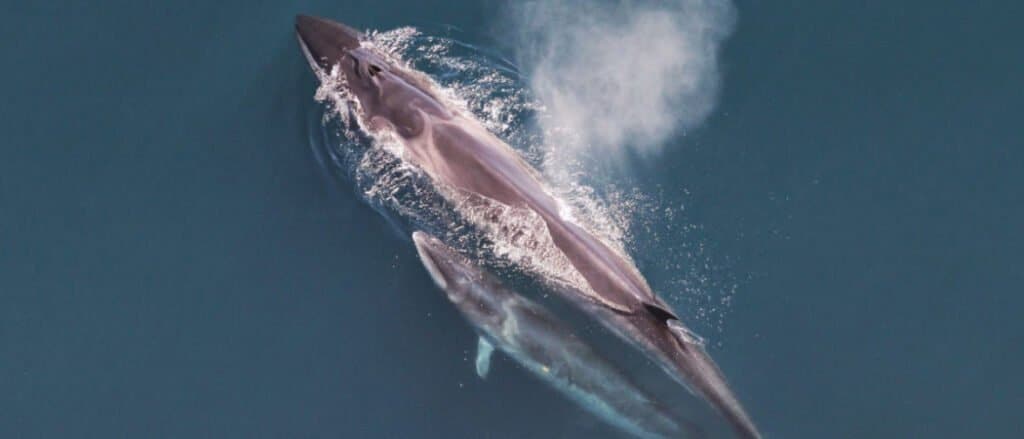
Sei whales (
Balaenoptera borealis) are the third largest whale in the world.
©Christin Khan, NOAA / NEFSC, Public domain, via Wikimedia Commons – License
Appearance: The sei whale is steel grey and has a lighter-colored underside. They fall victim to cookie-cutter sharks and may have telltale holes from bites. Their bodies are long and slender with a sloping head.
Size: 46 – 49 feet long and are the third largest whale in the world after blue and fin whales.
Weight: Up to 100,000 pounds but are typically 40,000 – 60,000 pounds
Speed: but can swim 30 miles per hour in short bursts.
Lifespan: On average, they live 60 years but have been recorded living
Conservation Status: only 57,000 – 65,000 are left.
Info: The sei whale feeds along the top of the water, catching small planktonic crustaceans called copepods, krill, and tiny fish. Their only known predators are humans and killer whales. The whales were one of the last species to be whaled, and since they have protection through the IWC, unfortunately, Japan still hunts them.
The sei whales prefer the temperate and sub-polar waters but tend to vary greatly on where they can be found yearly. They calve in the cooler winter waters after a 10 – 12 month gestation period. Not much is known about sei whales.
6. Sperm Whale (Physeter macrocephalus)
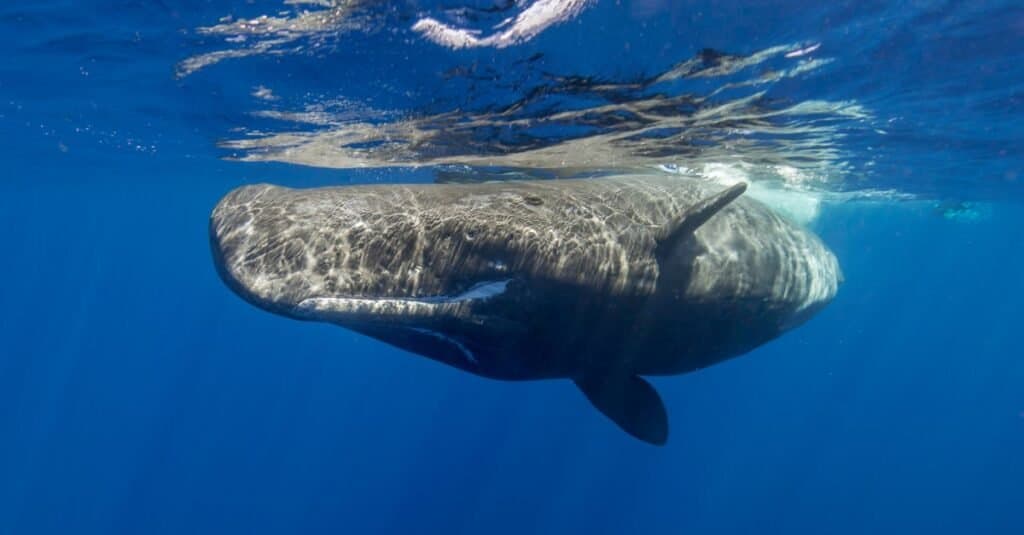
Adult male sperm whales (
Physeter macrocephalus) weigh as much as 700 adult humans combined.
©wildestanimal/Shutterstock.com
Appearance: The sperm whale has an enormous head, taking up 1/3 of their body’s length. They are also the largest toothed cetacean. Most baleen whales have teeth on the bottom jaw for catching larger prey or a system to filter food through along with water, but the sperm whale has teeth on the top, as well. The whales are dark grey or brown with a wrinkled appearance. They have small flippers, a narrow bottom jaw, and a small bump for a dorsal fin. The whales have a single blowhole at the left frontmost area of the head.
Size: 33 – 40 feet long for females and 49 – 59 feet long for males
Weight: 70,000 – 90,000 pounds for males and 28,000 – 36,000 pounds for females
Speed: Their cruising speed is 3 – 9 miles per hour, and they can swim at 22 – 28 miles per hour in short bursts.
Lifespan: 60 – 70 years, but some have lived longer.
Conservation Status: Endangered
Info: The sperm whale has a long history with humans and was once feared as a mythical sea monster in the 1800 -1900s and was the star of the book Moby Dick. They are not the largest whales in the ocean but they do have the largest brains of any animal in the world. They are also the furthest diving animals in the world. These whales prefer very deep open ocean waters and are not found near the coast unless the water is very deep, like in the Long Island Sound.
The sperm whale was named for the milky white substance found in an organ in their heads and was once thought to be sperm. The substance is called spermaceti.
7. Minke Whale (Balaenoptera acutorostrata)

Minke whales sneak up on boats and check them out but prefer to live as loners.
©Annie Leblanc/Shutterstock.com
Appearance: The minke whale has a pointed snout and sleek build, making it possible to cut through the ocean at high speeds. They have a backward-facing dorsal fin and are recognizable by the scars and notches on the fin by researchers.
Size: 18 – 35 feet long
Weight: 12,000 pounds
Speed: Their cruising speed is 9 – 19 miles per hour and 25 miles per hour in short bursts, which has saved them from being hunted by whalers. They can swim at 9 – 19 miles per hour for up to an hour.
Lifespan: 30 – 60 years
Conservation Status: Least concern
Info: Minke whales are super fast compared to most whales, and it comes in handy when hunting for dinner. They prefer sand eels and capelin but won’t pass up on krill or schools of small fish. The minke whale is a loner, preferring to spend their time alone. Occasionally, they can be seen swimming and feeding with two to three other minke whales.
Minke whales are related to blue, fin, and humpback whales. They are the smallest members of the Rorqual family, which is the largest group of baleen whales.
8. Long Finned Pilot Whale (Globicephala melas)

Long-finned pilot whales have several nicknames based on their looks: pothead and blackish.
©Andrew Sutton/Shutterstock.com
Appearance: The long-finned pilot whale is dark grey or black with a thick, powerful tail and round, melon-like head. Their dorsal fin is broad at the base and curved backward at the tip. The whales are very similar to dolphins or porpoises in terms of looks. Along with beluga whales, the two share a similar shape.
Size: 16 – 25 feet long
Weight: 1,800 pounds
Speed: Their cruising speed is 5 miles per hour, and they can swim 20 miles per hour in short bursts. They tend to swim in leaps and bounds, similar to a dolphin.
Lifespan: 35 – 60 years
Conservation Status: Least concern
Info: Long-finned pilot whales prefer the cold waters of deep temperate to sub-polar waters and live a mostly nomadic lifestyle. They do sometimes gather in groups of 100 whales or more to live and hunt together. The whales can dive 2,000 or more feet and remain there for 10 – 15 minutes when hunting squid and fish. Sometimes the pilot whales chase away their predator, the orcas.
They are known to babysit for other members of their pod. Generally, it is the males who perform the babysitting. These whales sometimes strand themselves in large numbers.
9. Beluga Whale (Delphinapterus leucas)
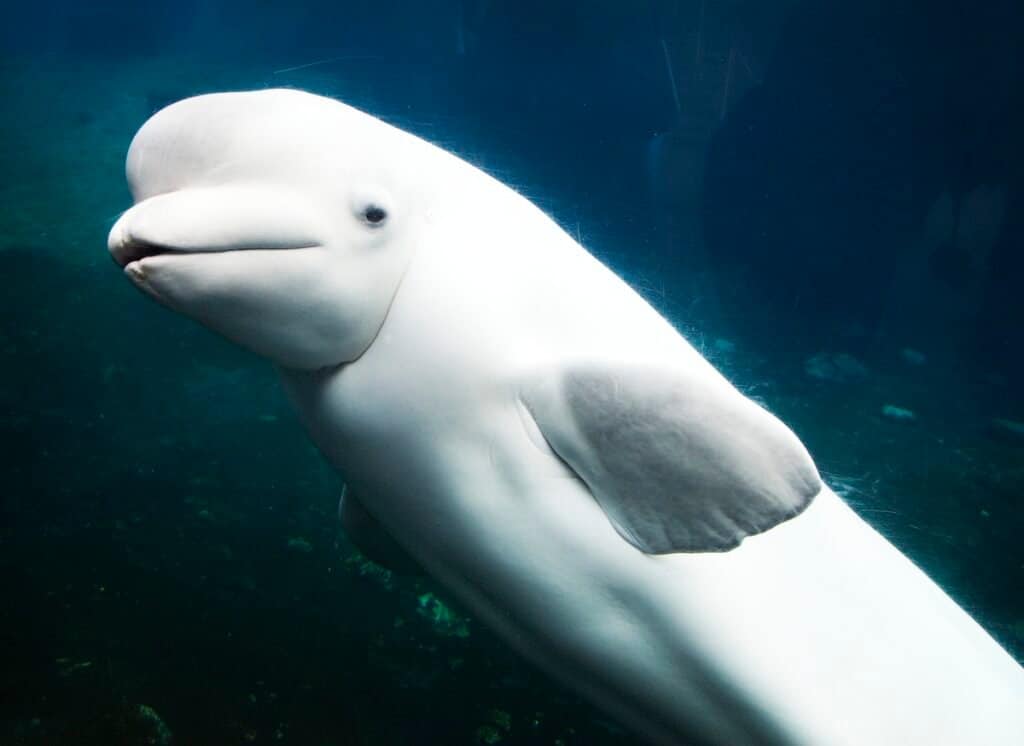
Beluga whales are also called the canary of the sea for the wide range of pitches they make.
©Carol M Highsmith / CC0 1.0, Rawpixel – License
Appearance: Small white whales with round heads, flattened dorsal fins, and muscular bodies. They have up to five inches of blubber to help keep them warm while in frigid waters. Their dorsal fin is flat against their body so as not to become injured by hitting planks of floating ice. As calves, the beluga whale is dark grey, but as they reach maturity, they become white.
Size: Up to 16 feet long
Weight: Males can weigh 2,400 – 3,500 pounds, and females are 1,500 – 2,600 pounds.
Speed: 2 – 6 miles per hour is the whale’s cruising speed, but they can swim 17 miles per hour for short bursts.
Lifespan: 35 – 50 years, though researchers now say the whales could reach 70 years or more in the wild.
Conservation Status: They are endangered only in the Cook Inlet area of Alaska.
Info: Beluga whales are one of the smallest whales and the most social. They live and hunt in groups or pods and sometimes can be found together in the hundreds during migration. Beluga whales enjoy playing much like dolphins and have been known to make toys, chase each other, spit water at each other, and swim alongside boats to check out the people. They raise their calves together in large estuaries during the summer months.
Beluga whales are rarely seen outside of Arctic or sub-Arctic waters but have been seen in the Long Island Sound several times before. Their only natural predators are killer whales and polar bears. When the ice thickens and blocks them into small areas, polar bears can drag them onto the ice.
The photo featured at the top of this post is © iStock.com/PaulWolf
Thank you for reading! Have some feedback for us? Contact the AZ Animals editorial team.






